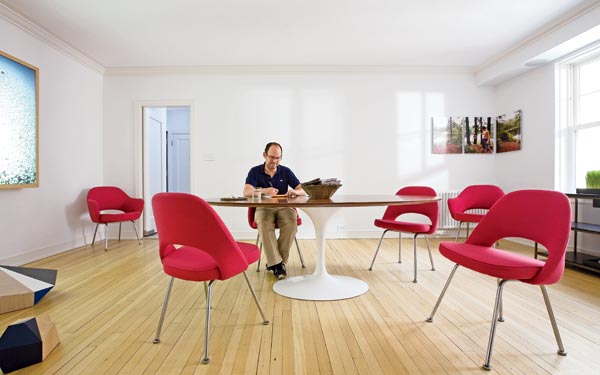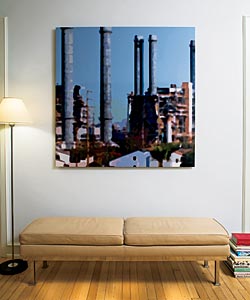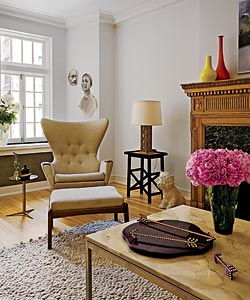
Adolph’s light-filled, airy vintage home is proof that the ideal background for a modern art collection need not be a loft space. Photo Gallery »
You might think that in the home of a chef, the kitchen would be the star of the show. Not so with Lorin Adolph, who has been cooking full-time for a local media/real-estate mogul for the past 18 years. It’s no slouch, the pristine space that Adolph’s extra virgin olive oil and fleur de sel call home. But it’s modest compared with the modern art collection—including works by David Hilliard, Robert Gober, and Darren Almond—that dots the rest of his 1920s East Lake View condo.
Adolph’s love of art grew out of his love of cooking. When he started his catering business in the mid 1980s, he was an impressionable twentysomething, working dinner parties in the homes of some of the city’s biggest art collectors. "I was soaking in that world," he says. "I would involve myself with what my clients were involved with. I’d look at their art and furniture. I’d go to the same auctions and benefits, and I would ask them questions." It wasn’t until years later that Adolph was able to bid on anything, but he educated himself by observing what others would buy—and occasionally participating in the process.
|
|
"It was easier to raise a paddle than go to a gallery and have to talk to people," he says. He now goes to galleries across the country, buying pieces that interest him and carefully incorporating them into every room of his home—including his bathroom (where he has a large photograph by Stuart Hawkins) and kitchen, where, on one of his open shelves, he has a series of six empty Old Milwaukee beer bottles etched with inscriptions like "Soused," "Plastered," and "Bombed" by local artist Adam Brooks. His friends know better than to mistake them for real booze.
"So often the kitchen is like an alien that doesn’t relate to the rest of the home," says Adolph, who has seen many a 42-inch-cherry-cabinet-filled kitchen over the course of his career. His own kitchen, like the rest of his apartment (which he gut-rehabbed three years ago, before moving in), is minimalist, white, and, thanks in part to advice from interior designer Douglas Levine, an old friend, balanced in a way you can’t pinpoint until Adolph elucidates.
"Doug always calls me when he’s cooking and asks me how I would do something, and I do the same with him with design. So after I bought this place, we went to his office and I sat at one computer calling out the dimensions of the Wolf stove I wanted, the Miele dishwasher, the Franke sink, while he sat at another computer with his draftsperson and the total square footage, and they laid it all out."
Levine observed that the stove and sink were on opposite sides of the galley-style kitchen but not symmetrical in the original layout, and pointed out that in a small space like this one, symmetry was essential to prevent the eye from jumping around too much (he positioned the appliances directly across from one another). He also encouraged Adolph to combine the adjacent butler’s pantry with the rest of the kitchen (Adolph had feared there might be a load-bearing wall dividing them; fortunately, there wasn’t), and together they created a seamless space with quiet choices in materials, such as the off-white Israeli limestone that morphs from backsplash into countertop, then reappears as tiles on the floor. White lacquered-wood lower cabinets and open shelves with recessed lights below them (Adolph doesn’t like harsh overhead light), along with plenty of supplemental shelving for cookbooks, make this room a modern-design-loving chef’s dream come true. And yet a vintage flavor remains in the form of hardware: Adolph chose "a modern version of an old door pull"—brushed nickel half-moon handles instead of traditional brass for the cabinets.
Adolph took the same respectful approach with the rest of his space. The original 1920s moldings, for example, had been "goopy, with picture rails and chair rails and moldings along the ceiling, all painted over multiple times"—not exactly the background that Adolph had imagined for his modern art collection.
Yet he didn’t want to strip the space entirely of its original character, so while he removed the picture and chair rails, he had the ceiling moldings refinished and the beat-up baseboards replaced with new ones that his contractor, Paul McCreedy, had custom-made to match the originals ("they look like they’ve always been there," says Adolph). He had the place painted white (flat acrylic on the walls and semi-gloss oil-based on the trim, for more depth) and most doors removed and repainted, their hinges and knobs dipped in nickel. Viewing the resulting crispness as art in itself, Adolph keeps accoutrements to a minimum. In his dining room (furnished with an original Saarinen table and chairs, a Paul McCobb sideboard, and a bar cart inherited from his grandmother), he has left almost an entire wall blank. In one corner he has a triptych of a forest scene by photographer David Hilliard.
"I would guess they are not meant to be hung that way," he says of the right-angle corner placement. "But I like how it draws your eye in." In another corner, a multipart geometric wood sculpture by Jeff Carter sits on the floor (placed thus despite the opinion of Levine, who felt the grouping looked better on a console; "I just envisioned it on the floor," says Adolph).
|
|
It’s clear that Adolph installs and buys his art (and furniture, for that matter) based on feeling, not rules. The first Ed Paschke he bought, in his 20s—a piece that had a lot of green in it—reminded him of the design of his business cards at the time. "It felt like home to me," he says of the painting.
He bought the dramatic Danish modern wingback chair in his living room from Modern Times (then in Wicker Park, now in West Town) years ago and doesn’t know the name of the designer. "I guess you don’t always need to know when you are so taken," he says. Similarly, he fell in love with the two Jens Risom–style chairs in his living room when gallery owner Douglas Dawson was selling them some 15 years ago from his personal collection; they were the first two pieces of serious furniture Adolph ever bought, and he knew nothing of their provenance. He just knew he wanted them.
He compares his visceral responses to cooking. "You see ingredients, you want to make something. You see a painting and it says something to you," he explains. "I’m drawn to different subject matter—just like one night I make my version of molecular gastronomy, and another night it’s lasagna."
What excites Adolph most is process, such as how artist Scott Short "takes a colored piece of paper and runs it through a copy machine and slowly strips all the color away, and then transposes what’s left onto a canvas and actually paints it." Adolph has one of Short’s works hanging in his living room. As a chef, he relates to it.
"In my job you start with a raw ingredient and then take it to a level where it’s best featured," he says. But while he’s been busy doing just that for his high-profile client, Adolph has been on an "art diet" for almost a year now. "It’s a relentless pursuit," he says. "But I’m at a point now that I just want to enjoy what I have."
For resource information, see Buyer’s Guide.
Photography: Eric Hausman
Styling: Barri Leiner
Related:




